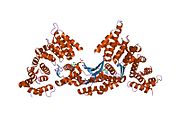HSPA6
Protein-coding gene in the species Homo sapiens
| HSPA6 | |||||||||||||||||||||||||||||||||||||||||||||||||||
|---|---|---|---|---|---|---|---|---|---|---|---|---|---|---|---|---|---|---|---|---|---|---|---|---|---|---|---|---|---|---|---|---|---|---|---|---|---|---|---|---|---|---|---|---|---|---|---|---|---|---|---|
 | |||||||||||||||||||||||||||||||||||||||||||||||||||
| |||||||||||||||||||||||||||||||||||||||||||||||||||
| Identifiers | |||||||||||||||||||||||||||||||||||||||||||||||||||
| Aliases | HSPA6, HSP70B', heat shock protein family A (Hsp70) member 6 | ||||||||||||||||||||||||||||||||||||||||||||||||||
| External IDs | OMIM: 140555; HomoloGene: 105648; GeneCards: HSPA6; OMA:HSPA6 - orthologs | ||||||||||||||||||||||||||||||||||||||||||||||||||
| |||||||||||||||||||||||||||||||||||||||||||||||||||
| |||||||||||||||||||||||||||||||||||||||||||||||||||
| |||||||||||||||||||||||||||||||||||||||||||||||||||
| |||||||||||||||||||||||||||||||||||||||||||||||||||
| Wikidata | |||||||||||||||||||||||||||||||||||||||||||||||||||
| |||||||||||||||||||||||||||||||||||||||||||||||||||
Heat shock 70 kDa protein 6 is a protein that in humans is encoded by the HSPA6 gene.[3][4]
References
- ^ a b c GRCh38: Ensembl release 89: ENSG00000173110 – Ensembl, May 2017
- ^ "Human PubMed Reference:". National Center for Biotechnology Information, U.S. National Library of Medicine.
- ^ Leung TK, Hall C, Rajendran M, Spurr NK, Lim L (Mar 1992). "The human heat-shock genes HSPA6 and HSPA7 are both expressed and localize to chromosome 1". Genomics. 12 (1): 74–9. doi:10.1016/0888-7543(92)90409-L. PMID 1346391.
- ^ "Entrez Gene: HSPA6 heat shock 70kDa protein 6 (HSP70B')".
Further reading
- Leung TK, Rajendran MY, Monfries C, et al. (1990). "The human heat-shock protein family. Expression of a novel heat-inducible HSP70 (HSP70B') and isolation of its cDNA and genomic DNA". Biochem. J. 267 (1): 125–32. doi:10.1042/bj2670125. PMC 1131254. PMID 2327978.
- Schiller P, Amin J, Ananthan J, et al. (1988). "Cis-acting elements involved in the regulated expression of a human HSP70 gene". J. Mol. Biol. 203 (1): 97–105. doi:10.1016/0022-2836(88)90094-0. PMID 3184191.
- Rensing SA, Maier UG (1994). "Phylogenetic analysis of the stress-70 protein family". J. Mol. Evol. 39 (1): 80–6. Bibcode:1994JMolE..39...80R. doi:10.1007/BF00178252. PMID 7545947. S2CID 37505045.
- Furlini G, Vignoli M, Re MC, et al. (1994). "Human immunodeficiency virus type 1 interaction with the membrane of CD4+ cells induces the synthesis and nuclear translocation of 70K heat shock protein". J. Gen. Virol. 75 (1): 193–9. doi:10.1099/0022-1317-75-1-193. PMID 7906708.
- Maruyama K, Sugano S (1994). "Oligo-capping: a simple method to replace the cap structure of eukaryotic mRNAs with oligoribonucleotides". Gene. 138 (1–2): 171–4. doi:10.1016/0378-1119(94)90802-8. PMID 8125298.
- Suzuki Y, Yoshitomo-Nakagawa K, Maruyama K, et al. (1997). "Construction and characterization of a full length-enriched and a 5'-end-enriched cDNA library". Gene. 200 (1–2): 149–56. doi:10.1016/S0378-1119(97)00411-3. PMID 9373149.
- Mercier PA, Winegarden NA, Westwood JT (1999). "Human heat shock factor 1 is predominantly a nuclear protein before and after heat stress". J. Cell Sci. 112. ( Pt 16) (16): 2765–74. doi:10.1242/jcs.112.16.2765. PMID 10413683.
- O'Keeffe B, Fong Y, Chen D, et al. (2000). "Requirement for a kinase-specific chaperone pathway in the production of a Cdk9/cyclin T1 heterodimer responsible for P-TEFb-mediated tat stimulation of HIV-1 transcription". J. Biol. Chem. 275 (1): 279–87. doi:10.1074/jbc.275.1.279. PMID 10617616.
- Agostini I, Popov S, Li J, et al. (2000). "Heat-shock protein 70 can replace viral protein R of HIV-1 during nuclear import of the viral preintegration complex". Exp. Cell Res. 259 (2): 398–403. doi:10.1006/excr.2000.4992. PMID 10964507.
- Gurer C, Cimarelli A, Luban J (2002). "Specific incorporation of heat shock protein 70 family members into primate lentiviral virions". J. Virol. 76 (9): 4666–70. doi:10.1128/JVI.76.9.4666-4670.2002. PMC 155079. PMID 11932435.
- Strausberg RL, Feingold EA, Grouse LH, et al. (2003). "Generation and initial analysis of more than 15,000 full-length human and mouse cDNA sequences". Proc. Natl. Acad. Sci. U.S.A. 99 (26): 16899–903. Bibcode:2002PNAS...9916899M. doi:10.1073/pnas.242603899. PMC 139241. PMID 12477932.
- Lim MC, Brooke SM, Sapolsky RM (2003). "gp120 neurotoxicity fails to induce heat shock defenses, while the over expression of hsp70 protects against gp120". Brain Res. Bull. 61 (2): 183–8. doi:10.1016/S0361-9230(03)00113-8. PMID 12832005. S2CID 35451084.
- Ota T, Suzuki Y, Nishikawa T, et al. (2004). "Complete sequencing and characterization of 21,243 full-length human cDNAs". Nat. Genet. 36 (1): 40–5. doi:10.1038/ng1285. PMID 14702039.
- Gerhard DS, Wagner L, Feingold EA, et al. (2004). "The status, quality, and expansion of the NIH full-length cDNA project: the Mammalian Gene Collection (MGC)". Genome Res. 14 (10B): 2121–7. doi:10.1101/gr.2596504. PMC 528928. PMID 15489334.
- v
- t
- e
PDB gallery
-
 1xqs: Crystal structure of the HspBP1 core domain complexed with the fragment of Hsp70 ATPase domain
1xqs: Crystal structure of the HspBP1 core domain complexed with the fragment of Hsp70 ATPase domain
External links
- HSPA6+protein,+human at the U.S. National Library of Medicine Medical Subject Headings (MeSH)
 | This article on a gene on human chromosome 1 is a stub. You can help Wikipedia by expanding it. |
- v
- t
- e
















